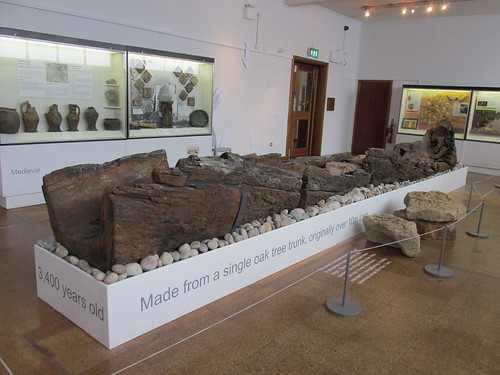 |
| Logboat |
Derby Museum and Art Gallery has a rather impressive specimen in its archaeology department. It's known as the Hanson logboat, because it was found in Hanson's gravel Quarry at Shardlow. (For those who are interested, Shardlow was an inland port during the height of canal transport. It still offers pleasure boaters a link from the Trent and Mersey Canal to the River Trent.) If you ever drive east along the A50 you can see the quarry just before you reach junction 24 of the M1.
The boat was made from a single oak tree, about 3,400 years ago, during the Bronze Age. Scientists used radiocarbon dating methods to reach that conclusion. Dendrochronolgy (tree ring counting) is a more exact science and it is possible with some wooden artefacts to determine exactly when the tree was cut down, but it requires the bark to define the last year of growth. If the bark is missing it's only possible to give a terminus post quem (time after which) for the object. In other words, if the outermost ring grew in 1434 BCE you can say for sure that the tree was cut down some time after that. But they haven't used dendrochronology on this boat.
 |
| The prow |
The boat contained large sandstone blocks, believed to have been its cargo. The rock was quarried a few miles away and was transported downstream, possibly to help build a causeway across the River Trent.

The boat is an amazing object isn't it? It makes you wonder about the people who made it and used it and possibly perished with it when it sank, or perhaps they were dragging it with another smaller boat? Who knows, there are so many possibilities:)
ReplyDeleteFascinating! I shall regard Derby with new respect next time I pass; I may even stop! I used to bathe in the gravel pits near/at Shardlow when I was a student (well, my chums did - I lazed about in the sunshine, drinking beer) and had no idea that anything this interesting had come out of the place. Astonishing.
ReplyDeleteThat's an amazing boat, imagine the time it must have taken to hollow out a tree trunk that size. Viking longships are superb though, they are so beautiful and graceful as well as being fast and seaworthy. I would love to visit the Viking Ship Museum in Oslo.
ReplyDeleteI know that we have blunted an electric saw trying to cut oak. Those Bronze Age guys must have had a deal of patience.
ReplyDeleteI studied European Neolithic, Bronze and Iron age prehistory at university - but finds like this just make me realise I know so very little!
ReplyDeleteI wonder how long it took them to hollow out, and what they used without iron tools?
And it's amazing to think of a straight oak of a size we don't have any more.
Thanks for sharing :)